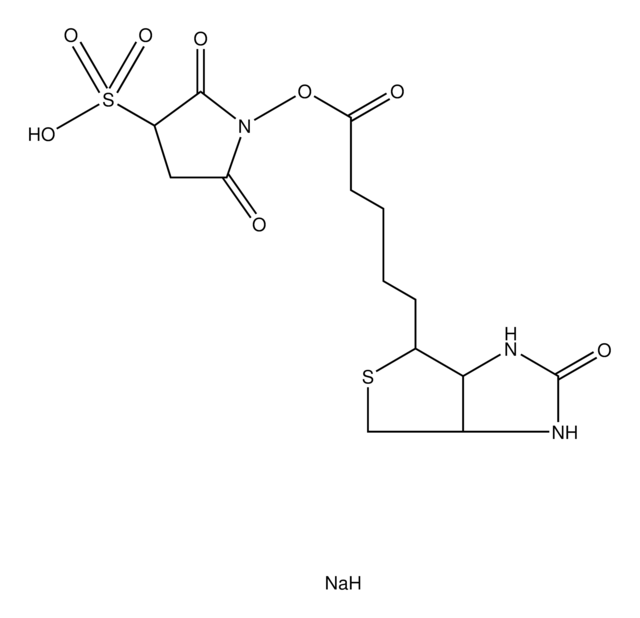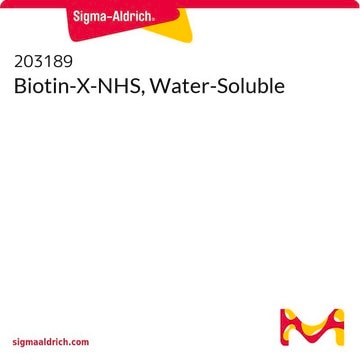B1022
Biotinamidohexanoic acid 3-sulfo-N-hydroxysuccinimide ester sodium salt
≥90% (TLC), powder
Synonim(y):
Sulfosuccinimidyl 6-(biotinamido)hexanoate
About This Item
Polecane produkty
Próba
≥90% (TLC)
Postać
powder
rozpuszczalność
H2O: 10 mg/mL
DMF: 50 mg/mL
temp. przechowywania
−20°C
ciąg SMILES
[Na].OS(=O)(=O)C1CC(=O)N(OC(=O)CCCCCNC(=O)CCCCC2SCC3NC(=O)NC23)C1=O
InChI
1S/C20H30N4O9S2.Na.H/c25-15(7-4-3-6-13-18-12(11-34-13)22-20(29)23-18)21-9-5-1-2-8-17(27)33-24-16(26)10-14(19(24)28)35(30,31)32;;/h12-14,18H,1-11H2,(H,21,25)(H2,22,23,29)(H,30,31,32);;
Klucz InChI
KDRVGWAQYRWAJF-UHFFFAOYSA-N
Szukasz podobnych produktów? Odwiedź Przewodnik dotyczący porównywania produktów
Opis ogólny
Zastosowanie
Oświadczenie o zrzeczeniu się odpowiedzialności
Hasło ostrzegawcze
Danger
Zwroty wskazujące rodzaj zagrożenia
Zwroty wskazujące środki ostrożności
Klasyfikacja zagrożeń
Repr. 1B
Kod klasy składowania
6.1C - Combustible acute toxic Cat.3 / toxic compounds or compounds which causing chronic effects
Klasa zagrożenia wodnego (WGK)
WGK 3
Temperatura zapłonu (°F)
Not applicable
Temperatura zapłonu (°C)
Not applicable
Certyfikaty analizy (CoA)
Poszukaj Certyfikaty analizy (CoA), wpisując numer partii/serii produktów. Numery serii i partii można znaleźć na etykiecie produktu po słowach „seria” lub „partia”.
Masz już ten produkt?
Dokumenty związane z niedawno zakupionymi produktami zostały zamieszczone w Bibliotece dokumentów.
Klienci oglądali również te produkty
Nasz zespół naukowców ma doświadczenie we wszystkich obszarach badań, w tym w naukach przyrodniczych, materiałoznawstwie, syntezie chemicznej, chromatografii, analityce i wielu innych dziedzinach.
Skontaktuj się z zespołem ds. pomocy technicznej














